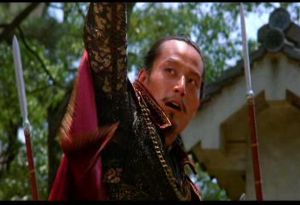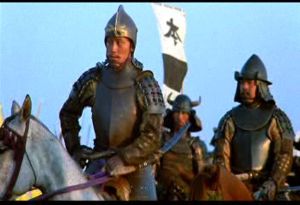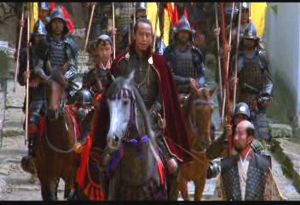|

This
red hat on top of a lance signifies the much-feared presence of
the warlord of Owari, Oda Nobunaga, in battlefields.
His taste in garments, architecture, interior design, food and
drinks, are known to be a (for a Japanese in 16th-century) maddening
salad of domestic, Chinese, and European stuff stewed together
into what can only be dubbed 'Nobunaga's style'. His much simplified
('Westernized') armor is one heck of an advantage at war, especially
for manoevers on horseback. Oda was the best rider of his days.
Those were the days of dressing gaily; only after the Tokugawas
became Shoguns, long after Oda's time, Japanese seemed to wear
nothing but dark colors, except courtesans.
 Click
here for story and pictures of the Tokugawa code of dress.
Click
here for story and pictures of the Tokugawa code of dress.
|
|

In Oda's days, both genders wore loud colors; women put on flowing
robes and wore unbound hair, their kimonos were loosely held in
place with narrow and soft obi (cloth belt wound around
the waist). The 'ginko chignon' and tighter kimonos with wide
and stiff obi, a typical image in 'Western' minds of Japanese
women, are the Tokugawan inventions, too. History varies when
it comes to how Oda Nobunaga did his hair; I tend to agree with
this movie where he doesn't shave the top of his head like all
other samurai, thus consistently deviated from the dress-codes
of the time. Btw, Oda Nobunaga is around 36-39 years old in the
period of history covered in this movie.
 Click
here for the origin of the trend-setters of Oda's times.
Click
here for the origin of the trend-setters of Oda's times.
|
|
 |
 |
|

|
In
this movie, Oda Nobunaga, with his ally Tokugawa Ieyasu
(warlord of Mikawa, who's only about 29-31 years old
at the time), is fighting against Takeda Shingen
of Kai between 1571 and 1575. Outbound mind, characteristic of
Oda, is shown via the map of the empire of Japan behind his seat
at the Gifu castle turret; also through the way he dresses --
Oda was the only one wearing 'Western' stuff at war, though at
home is is more or less 'normal'. The scene showing Portuguese
Catholic priests giving him a blessing before going to war is
typical, too. Oda, though, was never converted. He only used the
missionaries as a buffer against the warrior-monks of Buddhist
monasteries that kept on hatching schemes against him.
 Click
here for story and pictures of these Buddhist warrior-monks that
had given Oda Nobunaga the stigma of evil since 1600 until today.
Click
here for story and pictures of these Buddhist warrior-monks that
had given Oda Nobunaga the stigma of evil since 1600 until today.
|
|
|

Tokugawa
Ieyasu (in full court-dress) bowing to Oda Nobunaga (who never
bowed to anybody but the Emperor). Oda was busy suppressing the
rebellion of his own brother in-law Asai Nagamasa,
warlord of Omi, husband of his most famous and favorite younger
sister Oichi. So he couldn't lend a hand to Tokugawa
in the previous battle against Takeda Shingen. Oda makes up to
his ally by giving him a bag of gold and the second-best horse
in his battlecamp.
 Click
here for story and pictures of Asai Nagamasa and Oda's sister
Lady Oichi.
Click
here for story and pictures of Asai Nagamasa and Oda's sister
Lady Oichi.
|
|

Oda
with Tokugawa (a little behind him at the right) and the best
of the Tokugawa Generals, Honda Heihachi. Honda
is wearing his famous Viking-like iron helmet and fluttering his
own simple flag of the Japanese character that reads 'hon', behind
Oda's left side. In real history, Honda played a great part in
ensuring that the Tokugawa clan would reign over Japan for the
next three centuries. The clan only let Japan go in 1870's.
 Click
here for story and pictures of the Tokugawa clan.
Click
here for story and pictures of the Tokugawa clan.
 Click here for
profile & pictures of Honda Heihachi
Click here for
profile & pictures of Honda Heihachi
|
|
 |
 |
|

 Click here for
detailed and complete maps of Japan, all the provinces and warlords,
and locations of all the places mentioned in this movie.
Click here for
detailed and complete maps of Japan, all the provinces and warlords,
and locations of all the places mentioned in this movie.
|
|










